URM37_V3.2_Ultrasonic_Sensor_(SKU_SEN0001) - jimaobian/DFRobotWiki GitHub Wiki
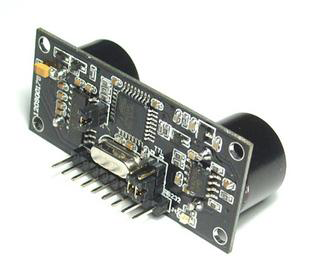 urm37 v3.2 ultrasonic sensor uses an industrial level avr processor as the main processing unit. it comes with a temperature correction which is very unique in its class.
urm37 v3.2 ultrasonic sensor uses an industrial level avr processor as the main processing unit. it comes with a temperature correction which is very unique in its class.
- Power: +5V
- Current: <20mA
- Working temperature: -10℃~+70℃
- Detecting range: 4cm-5m
- Resolution: 1cm
- Interface: RS232 (TTL), PWM
- Servo control: One servo control output
- Operating Mode: Serial; (PWM) passive control mode; Autonomous Mode; On/OFF Mode
- Temperature sensor: 12 bits reading from serial port
- Size: 22mm × 51 mm
- Weight: 30g
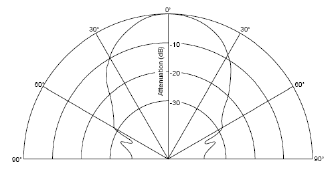
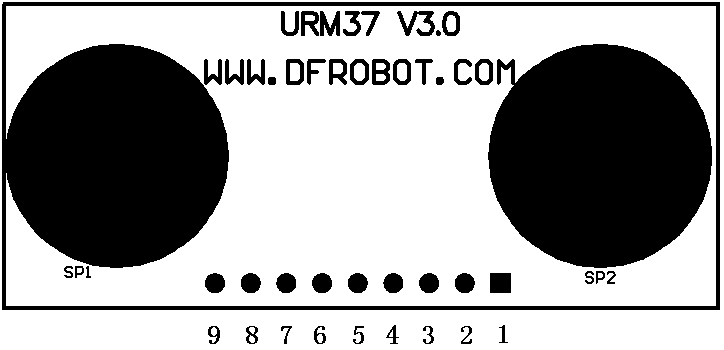 1. +VCC - +5V Power
2. GND - Ground
3. RST - Reset
4. PWM - PWM Output 0-25000US,Every 50US represent 1cm
5. ' MOTO' - Servo control signal output
6. COMP/TRIG
::COMP - On/OFF mode, when the detecting distance is smaller than a pre-set value, this pin pulls low.
::TRIG - PWM or RS232 trigger pin
7. NC
8. RXD - RS232,TTL communication
9. TXD - RS232,TTL communication
1. +VCC - +5V Power
2. GND - Ground
3. RST - Reset
4. PWM - PWM Output 0-25000US,Every 50US represent 1cm
5. ' MOTO' - Servo control signal output
6. COMP/TRIG
::COMP - On/OFF mode, when the detecting distance is smaller than a pre-set value, this pin pulls low.
::TRIG - PWM or RS232 trigger pin
7. NC
8. RXD - RS232,TTL communication
9. TXD - RS232,TTL communication
Compare with SRF08 and XL-MaxSonar-WRC1 Ultrasonic Distance Sensor Evaluating
- 1×URM37 V3.2 Ultrasonic Sensor
- 1×Arduino Microcontroller
- 1×IO Expansion Shield For Arduino(V5)
- 1×USB cable
- 4×jumper wire
- Arduino IDE
The working mode can be changed by writing 0x00, 0x01 or 0x02 to EEPROM through serial port.
Under this mode, the sensor is always waiting for command from serial port. Every time it receives a command, it will return the distance and wait for the next command. The degree in the command will be used to control a servo motor to rotate corresponding degree. Please note that this mode is always on. It can not be switch on or off.
The selection of RS232 or TTL output level is switched by changing three jumpers (J1, J2, J3). A diagram below illustrates the setting:
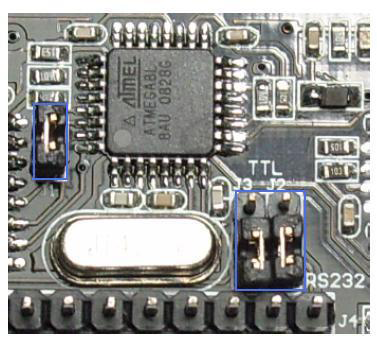
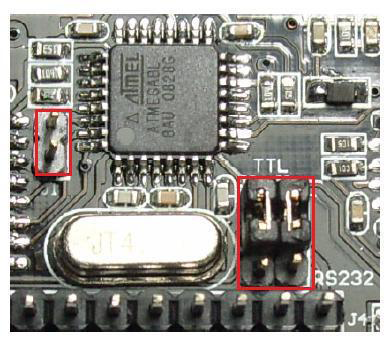 Warning: Do not connect to TTL MCU when the output mode is set to RS232, doing so will permanently damage the unit.
Warning: Do not connect to TTL MCU when the output mode is set to RS232, doing so will permanently damage the unit.
This feature is only available for Rev2 and after. If there are no jumpers on the back of the sensor, the sensor is Rev1 and hence not supporting this feature.
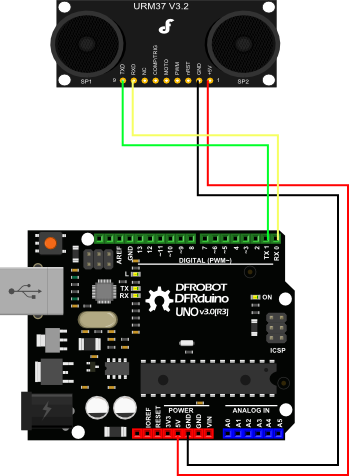

After you have connected the module according to the diagram,you can use our "URMV3.2HelpMate" to test the module online 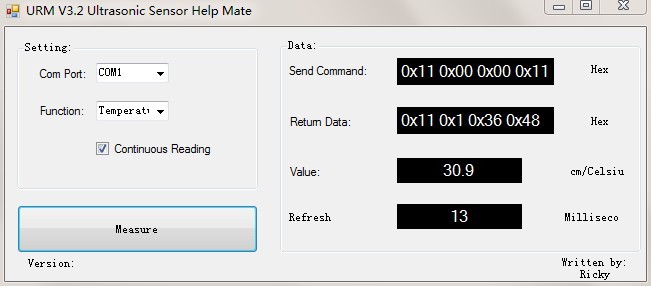 the usage of the software is very simple: ensure that there is no other software on the computer takes up the serial port, and then running mate, select the com port, and choose the parameter what you want to measure,and choose the "continuous reading ".click "Measure" it will measure the temperature and the distance.
the usage of the software is very simple: ensure that there is no other software on the computer takes up the serial port, and then running mate, select the com port, and choose the parameter what you want to measure,and choose the "continuous reading ".click "Measure" it will measure the temperature and the distance.
Under this mode, the sensor will make a sensor reading every 25ms and compare the reading with a threshold (pre-set, user is able to define this value by writing EEPROM), if the reading is equal or smaller than the threshold, pin COMP/TRIG will have low output. In the meantime, pin PWM will output the distance reading, every 50us low level stands for 1cm, by counting the number of these pulses, the distance can be calculated. This mode can be simply used as an ON/OFF switch. First you need to write the desired distance threshold into the sensor module. Using the serial port and the following code.
The way to write its EEPROM can be found in the code below. And the distance is stored in address 0x00 and 0x01 in cm, that's to say if the threshold you want is 15cm, you should write a 0x0f(as 0x0f is equal to 15 )into address 0x00 and 0x00 in address 0x01,and never forget that once you change the distance threshold,the sum is also needed to be corrected. Details for the data is in the table below. Briefly, works like this cmd1<cmd, address, data, checksum>
''' checkSum = Low 8 bit of the sum of command+data0+data1 '''
// # Editor :Holiday from DFRobot
// # Data :30.05.2013
// # Product name:ultrasonic scanner
// # Product SKU:SEN0001
// # Version : 3.2
// # Description:
// # This sample shows how to use the Autonomous trigger mode by writing its EEPROM
// # Connection:
// # Pin 1 VCC (URM V3.2) -> VCC (Arduino)
// # Pin 2 GND (URM V3.2) -> GND (Arduino)
// # Pin 6 COMP/TRIG (URM V3.2) -> Pin 2 (Arduino)
// #
int cmmd1[]={
0x44,0x00,0x10,0x54};//low byte stored in the sensor for the distance threshold.
int cmmd2[]={
0x44,0x01,0x00,0x45};//high byte, write 0x0010 into address 0x01 and 0x00,so the threshold is set to 16cm
int cmmd3[]={
0x44,0x02,0xaa,0xf0};// Autonomous mode. write 0xaa into address 0x02
//int cmmd3[]={
// 0x44,0x02,0xbb,0x01}; // PWM mode. write 0xbb into address 0x02
int i;
void setup(){
Serial.begin(9600); // Sets the baud rate to 9600
A_Mode_Setup(); //PWM mode setup function
}
void loop()
{
}
void A_Mode_Setup(){
//write the data into the URM37 EEPROM
for (i=0;i<4;i++)
Serial.write(cmmd3[i]);
delay(200);
for (i=0;i<4;i++)
Serial.write(cmmd1[i]);
delay(200);
for (i=0;i<4;i++)
Serial.write(cmmd2[i]);
delay(200);
}Remember to unplug the serial pins from Arduino before uploading your code.
After the code is uploaded, press reset on your Arduino board to confirm it is written on the module. Then you can connect your sensor with the following wiring system. And just read the pin for changes, when the threshold distance is reached. 
int pin = 13;
volatile int state = LOW;
void setup(){
pinMode(pin, OUTPUT);
attachInterrupt(0, user_diy, CHANGE); //The ON/OFF switch can be used as a singal of interruption
}
void loop(){
digitalWrite(pin, state);
}
void user_diy() //user can give your own code in this interruput function
{
state = !state;
}====Mode 3: PWM passive control mode==== Under this mode, a low pull on pin COMP/TRIG will trigger a sensor reading. The width of the pulse is proportional to the servo rotating degree. After a successful sensor reading, Pin PWM will output pulses, every 50us represents 1cm. If the reading is invalid, a 50000us pulse will be returned.
// # Editor :Jiang from DFRobot
// # Data :18.09.2012
// # Product name:ultrasonic scanner
// # Product SKU:SEN0001
// # Version : 0.2
// # Description:
// # The Sketch for scanning 180 degree area 4-500cm detecting range
// # Connection:
// # Pin 1 VCC (URM V3.2) -> VCC (Arduino)
// # Pin 2 GND (URM V3.2) -> GND (Arduino)
// # Pin 4 PWM (URM V3.2) -> Pin 3 (Arduino)
// # Pin 6 COMP/TRIG (URM V3.2) -> Pin 5 (Arduino)
// #
int URPWM = 3; // PWM Output 0-25000US,Every 50US represent 1cm
int URTRIG=5; // PWM trigger pin
unsigned int Distance=0;
uint8_t EnPwmCmd[4]={0x44,0x02,0xbb,0x01}; // distance measure command
void setup()
{ // Serial initialization
Serial.begin(9600); // Sets the baud rate to 9600
PWM_Mode_Setup();
}
void loop()
{
PWM_Mode();
delay(20);
} //PWM mode setup function
void PWM_Mode_Setup()
{
pinMode(URTRIG,OUTPUT); // A low pull on pin COMP/TRIG
digitalWrite(URTRIG,HIGH); // Set to HIGH
pinMode(URPWM, INPUT); // Sending Enable PWM mode command
for(int i=0;i<4;i++)
{
Serial.write(EnPwmCmd[i]);
}
}
void PWM_Mode()
{ // a low pull on pin COMP/TRIG triggering a sensor reading
digitalWrite(URTRIG, LOW);
digitalWrite(URTRIG, HIGH); // reading Pin PWM will output pulses
unsigned long DistanceMeasured=pulseIn(URPWM,LOW);
if(DistanceMeasured>=10200)
{ // the reading is invalid.
Serial.println("Invalid");
}
else
{
Distance=DistanceMeasured/50; // every 50us low level stands for 1cm
Serial.print("Distance=");
Serial.print(Distance);
Serial.println("cm");
}
}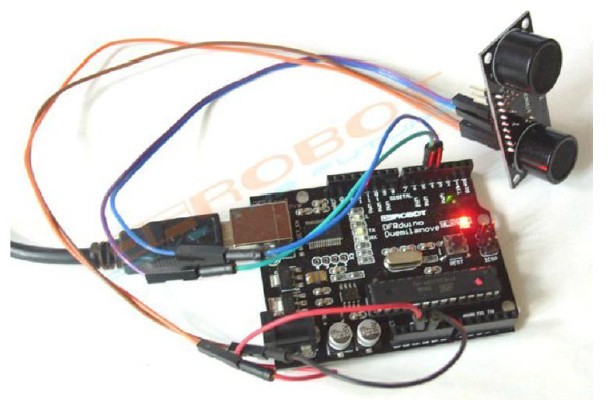
Serial setting:Port rate: 9600; Parity: none; Stop bit: 1
Command: Control command consists of four bits, command+data0+data1+sum. Sum=Low 8 bit of the sum of command+data0+data1.
Command Format |
Function |
Description |
|---|---|---|
0x11+NC+NC+Sum (Sample: 0x11 0x00 0x00 0x11) |
Enable 16 bit temperature reading |
Reading the temperature, the return data format will be: 0x11+High(temperature)+Low(temperature)+SUM |
0x22+Degree+NC+SUM (Sample: 0x22 0x00 0x00 0x22 ) |
Enable 16 bit distance reading |
The degree in the command is used to control a servo motor to rotate corresponding degree. |
0x33+Add+NC+SUM |
Enable internal EEPROM reading |
Return data will be 0x33+Add+Data+SUM. |
0x44+Add+Data+SUM (Sample: 0x44 0x02 0xbb 0x01) Enable PWM mode |
Enable internal EEPROM writing |
Written data can only from 0-255. Address 0x00-0x02 is used to configure the mode. 0x00 – threshold distance (Low) 0x01 – threshold distance (High) 0x02 – Operation Mode (0xaa for autonomous mode) (0xbb for PWM passive control mode) |
Note:NC stands for any data,SUM stands for sum, Add stands for address.
1. PWN_ON must be set to High to enable sensor.
Examples: Function to calculate the temperature:
IF(HightByte>=0xF0)
{
Temperature= ((HightByte-0xF0)*256-LowByte)/10
}
Else
{
Temperature= ((HightByte)*256-LowByte)/10
}
Servo control command reference table:
| DEC | 0 | 1 | 2 | 3 | 4 | 5 | 6 | 7 | 8 | 9 | 10 | 11 | 12 | 13 | 14 | 15 |
| HEX | 0 | 01 | 02 | 03 | 04 | 05 | 06 | 07 | 08 | 09 | 0A | 0B | 0C | 0D | 0E | 0F |
| Degree | 0 | 6 | 12 | 18 | 24 | 29 | 35 | 41 | 47 | 53 | 59 | 65 | 70 | 76 | 82 | 88 |
| DEC | 16 | 17 | 18 | 19 | 20 | 21 | 22 | 23 | 24 | 25 | 26 | 27 | 28 | 29 | 30 | 31 |
| HEX | 10 | 11 | 12 | 13 | 14 | 15 | 16 | 17 | 18 | 19 | 1A | 1B | 1C | 1D | 1E | 1F |
| Degree | 94 | 100 | 106 | 112 | 117 | 123 | 129 | 135 | 141 | 147 | 153 | 159 | 164 | 170 | 176 | 182 |
| DEC | 32 | 33 | 34 | 35 | 36 | 37 | 38 | 39 | 40 | 41 | 42 | 43 | 44 | 45 | 46 | |
| HEX | 20 | 21 | 22 | 23 | 24 | 25 | 26 | 27 | 28 | 29 | 2A | 2B | 2C | 2D | 2E | |
| Degree | 188 | 194 | 200 | 206 | 211 | 217 | 223 | 229 | 235 | 241 | 247 | 252 | 258 | 264 | 270 |
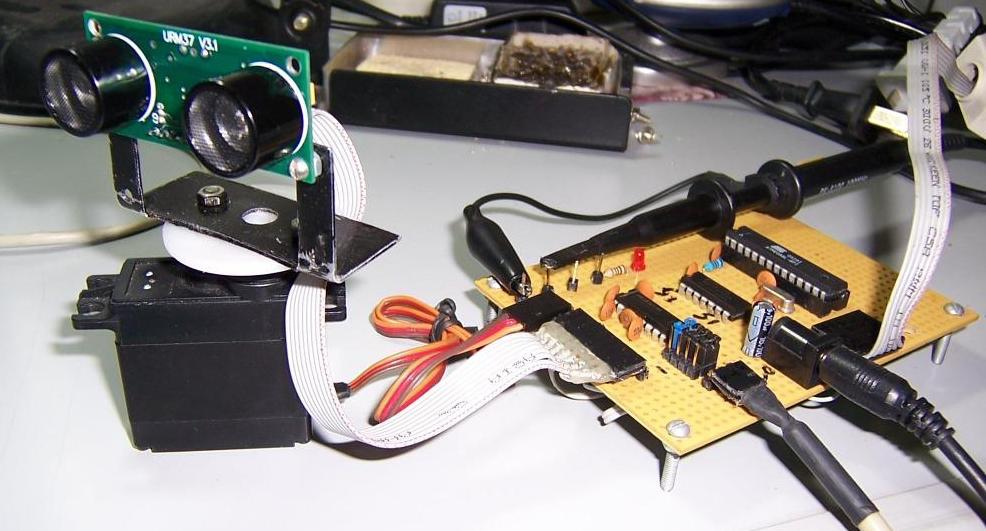 V3.2 Help Mate Download:
V3.2 Help Mate Download:
Use a servo to control the position,and the ultrasonic sensor to judge the distance.Here is the sketch. 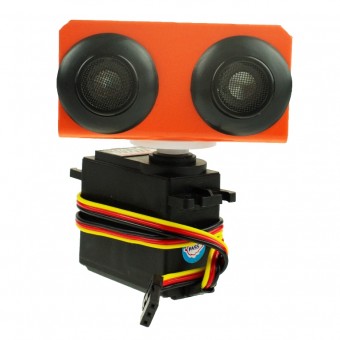 NOTE: Please put the sensor jumpers to TTL mode. See above for a picture indicating TTL mode
NOTE: Please put the sensor jumpers to TTL mode. See above for a picture indicating TTL mode
// # Editor : Jiang from DFRobot
// # Data : 24.07.2012
// # Product name:ultrasonic scanner Kit
// # Product SKU:SEN0001
// # Version : 0.2
// # Description:
// # The Sketch for scanning 180 degree area 4-500cm detecting range
// # Connection:
// # Pin 1 VCC (URM V3.2) -> VCC (Arduino)
// # Pin 2 GND (URM V3.2) -> GND (Arduino)
// # Pin 4 PWM (URM V3.2) -> Pin 3 (Arduino)
// # Pin 6 COMP/TRIG (URM V3.2) -> Pin 5 (Arduino)
// # Pin mode: PWM
// # Working Mode: PWM passive control mode.
// # If it is your first time to use it,please make sure the two jumpers to the right hand
// # side of the device are set to TTL mode. You'll also find a secondary jumper on
// # the left hand side, you must break this connection or you may damage your device.
#include <Servo.h> // Include Servo library
Servo myservo; // create servo object to control a servo
int pos=0; // variable to store the servo position
int URPWM=3; // PWM Output 0-25000us,every 50us represent 1cm
int URTRIG=5; // PWM trigger pin
boolean up=true; // create a boolean variable
unsigned long time; // create a time variable
unsigned long urmTimer = 0; // timer for managing the sensor reading flash rate
unsigned int Distance=0;
uint8_t EnPwmCmd[4]={0x44,0x22,0xbb,0x01}; // distance measure command
void setup(){ // Serial initialization
Serial.begin(9600); // Sets the baud rate to 9600
myservo.attach(9); // Pin 9 to control servo
PWM_Mode_Setup();
}
void loop(){
if(millis()-time>=20){ // interval 0.02 seconds
time=millis(); // get the current time of programme
if(up){ // judge the condition
if(pos>=0 && pos<=179){
pos=pos+1; // in steps of 1 degree
myservo.write(pos); // tell servo to go to position in variable 'pos'
}
if(pos>179) up= false; // assign the variable again
}
else {
if(pos>=1 && pos<=180){
pos=pos-1;
myservo.write(pos);
}
if(pos<1) up=true;
}
}
if(millis()-urmTimer>50){
urmTimer=millis();
PWM_Mode();
}
}
void PWM_Mode_Setup(){
pinMode(URTRIG,OUTPUT); // A low pull on pin COMP/TRIG
digitalWrite(URTRIG,HIGH); // Set to HIGH
pinMode(URPWM, INPUT); // Sending Enable PWM mode command
for(int i=0;i<4;i++){
Serial.write(EnPwmCmd[i]);
}
}
void PWM_Mode(){ // a low pull on pin COMP/TRIG triggering a sensor reading
digitalWrite(URTRIG, LOW);
digitalWrite(URTRIG, HIGH); // reading Pin PWM will output pulses
unsigned long DistanceMeasured=pulseIn(URPWM,LOW);
if(DistanceMeasured==50000){ // the reading is invalid.
Serial.print("Invalid");
}
else{
Distance=DistanceMeasured/50; // every 50us low level stands for 1cm
}
Serial.print("Distance=");
Serial.print(Distance);
Serial.println("cm");
}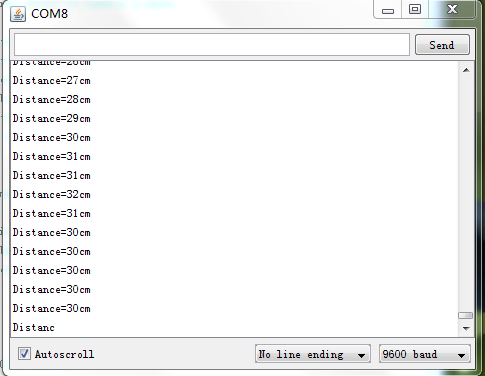
- Arduino Library from milesburton(IDE 0023 and below)
- Arduino Library from Lauren(Only Arduino IDE 1.0)
 shopping urm37 v3.2 ultrasonic sensor manual - rev 2.2 (sku:sen0001)
shopping urm37 v3.2 ultrasonic sensor manual - rev 2.2 (sku:sen0001)